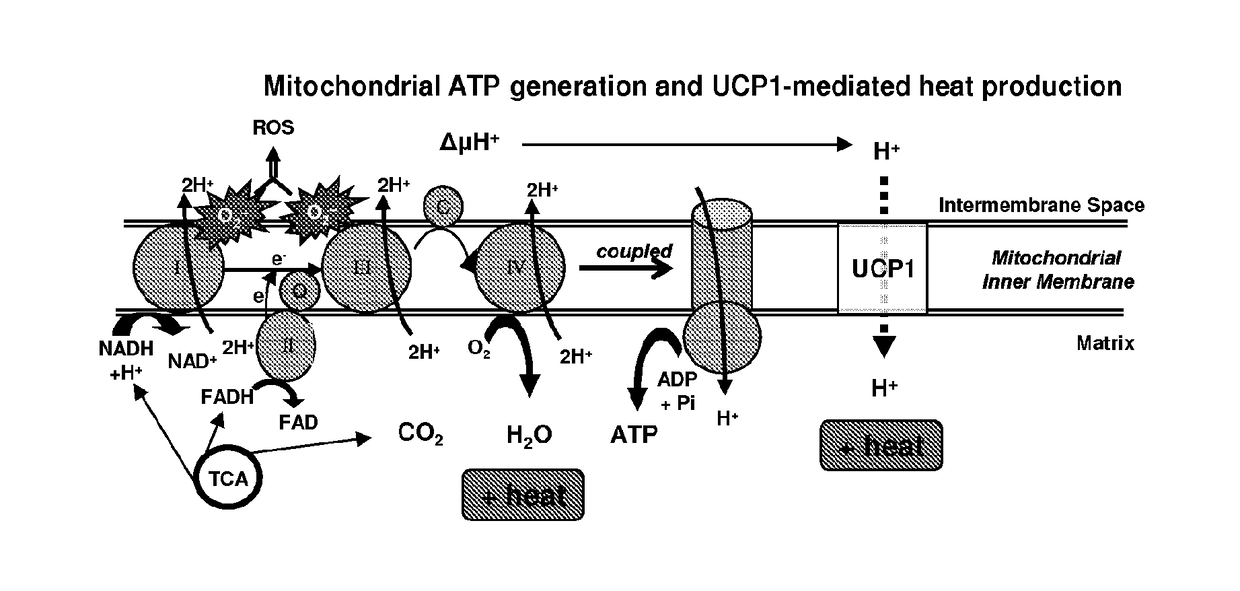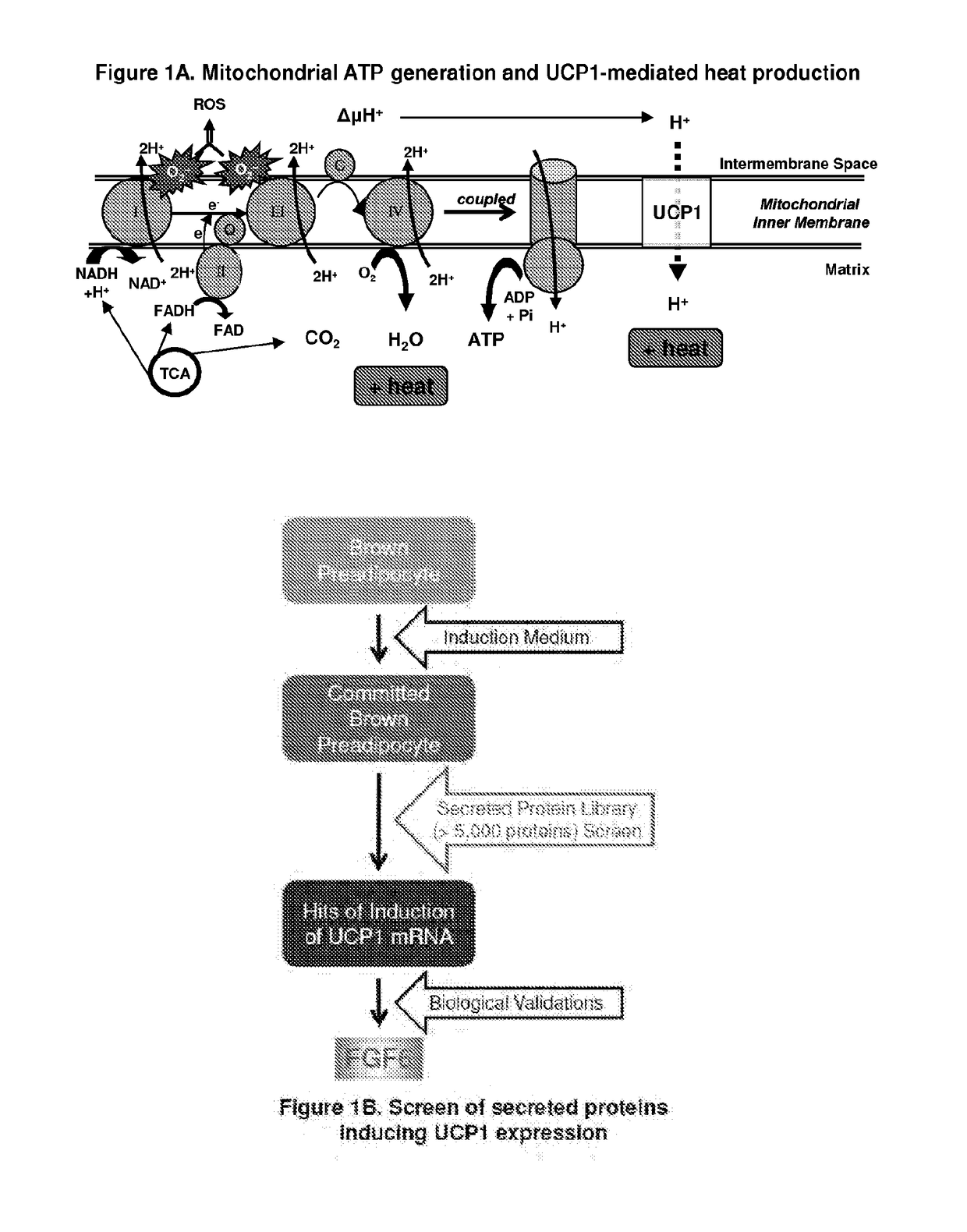Methods and compositions for induction of ucp1 expression
a technology of induction and expression, applied in the field of methods and compositions for inducing ucp1 expression, can solve the problem that no factor has been identified that is able to induce ucp1 expression, and achieve the effect of lowering the weight of a subject and lowering the weight of the subj
- Summary
- Abstract
- Description
- Claims
- Application Information
AI Technical Summary
Benefits of technology
Problems solved by technology
Method used
Image
Examples
example 1
ces Uncoupling Protein 1 (UCP1) Expression in Brown Preadipocytes in the Absence of Differentiation, without Causing Cell Proliferation
[0237]Brown adipocytes are characterized by multiple small lipid droplets and abundant mitochondria that oxidize nutrients and generate heat. Central to their thermogenic activity is UCP1, which is uniquely expressed in brown adipose tissue (BAT), and therefore serves as a defining marker of brown adipocytes. UCP1 is a 32 kDa inner mitochondrial transmembrane protein expressed only in brown adipocytes that allows protons in the mitochondrial intermembrane space to re-enter the mitochondrial matrix without generating ATP, i.e., uncoupling. Heat is generated directly by protons rushing down their electrochemical gradient and also indirectly by the subsequent increase in flux through the electron transport chain that follows (FIG. 1A). This process is also known as thermogenesis. UCP1 is unique to BAT and is necessary to mediate BAT thermogenesis. While...
example 2
ssion of FGF6 in Brown or White Preadipocyte Cell Lines Induces UCP1 Expression and Mitochondrial Respiration
[0257]In FGF6-treated cells, a surprisingly high level of UCP1 expression was observed (see FIGS. 3A-D and 4A-C), as well as a surge in acidification of culture media indicating increased mitochondrial metabolism (FIG. 3D). To assess FGF6's role in the regulation of mitochondrial activity, FGF6 was stably expressed in WT-1 brown preadipocytes and 3T3-F442A white preadipocytes. Stable cells were generated by viral infection followed by drug selection.
Mitochondrial Respiration and Activity
[0258]Consistent with the findings described above, overexpression of FGF6 greatly increased UCP1 expression over basal level in WT-1 brown preadipocytes, as described in FIG. 5A. When placed on the Seahorse Bioanalyzer for analysis of bioenergetic potential, these cells displayed robust increases in mitochondrial activity when abundant nutrients were provided (10 mM glucose, 0.5 mM carnitine,...
example 3
ces UCP1 Expression in Primary Adipose Progenitors, but has No Apparent Effect on Myogenic Progenitors
[0263]To determine if FGF6 treatment of primary adipose progenitors could also increase UCP1 expression as observed in Example 1, stromo-vascular fraction (SVF) cells, which comprise adipocyte progenitors, were isolated from interscapular brown adipose tissue (BAT-SVF) and subcutaneous white adipose tissue (SQ-SVF). SVF cells were subsequently treated with FGF6 or FGF21 in growth media (DMEM+10% FBS) for 3 days, followed by determination of UCP1 expression. The results of the experiments are provided in FIGS. 9A-C. As described in FIGS. 9A and 9B, FGF21 treatment had little effect on UCP1 mRNA expression in either type of SVF cells, as compared to the control. In contrast, FGF6 induced a 4-fold increase of UCP1 mRNA expression in BAT-SVF (FIG. 9A), and a nearly 200-fold increase in UCP1 mRNA expression in SVF derived from subcutaneous WAT (FIG. 9B) as compared to the control.
[0264]T...
PUM
| Property | Measurement | Unit |
|---|---|---|
| Dimensionless property | aaaaa | aaaaa |
| Dimensionless property | aaaaa | aaaaa |
| Weight | aaaaa | aaaaa |
Abstract
Description
Claims
Application Information
 Login to View More
Login to View More - R&D
- Intellectual Property
- Life Sciences
- Materials
- Tech Scout
- Unparalleled Data Quality
- Higher Quality Content
- 60% Fewer Hallucinations
Browse by: Latest US Patents, China's latest patents, Technical Efficacy Thesaurus, Application Domain, Technology Topic, Popular Technical Reports.
© 2025 PatSnap. All rights reserved.Legal|Privacy policy|Modern Slavery Act Transparency Statement|Sitemap|About US| Contact US: help@patsnap.com



